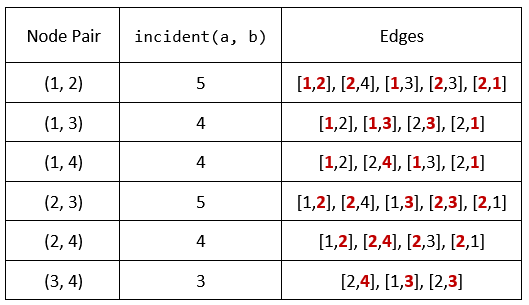
g1701_1800.s1782_count_pairs_of_nodes.readme.md Maven / Gradle / Ivy
Go to download
Show more of this group Show more artifacts with this name
Show all versions of leetcode-in-java Show documentation
Show all versions of leetcode-in-java Show documentation
Java-based LeetCode algorithm problem solutions, regularly updated
The newest version!
1782\. Count Pairs Of Nodes
Hard
You are given an undirected graph defined by an integer `n`, the number of nodes, and a 2D integer array `edges`, the edges in the graph, where edges[i] = [ui, vi] indicates that there is an **undirected** edge between ui and vi. You are also given an integer array `queries`.
Let `incident(a, b)` be defined as the **number of edges** that are connected to **either** node `a` or `b`.
The answer to the jth query is the **number of pairs** of nodes `(a, b)` that satisfy **both** of the following conditions:
* `a < b`
* `incident(a, b) > queries[j]`
Return _an array_ `answers` _such that_ `answers.length == queries.length` _and_ `answers[j]` _is the answer of the_ jth _query_.
Note that there can be **multiple edges** between the same two nodes.
**Example 1:**

**Input:** n = 4, edges = [[1,2],[2,4],[1,3],[2,3],[2,1]], queries = [2,3]
**Output:** [6,5]
**Explanation:** The calculations for incident(a, b) are shown in the table above. The answers for each of the queries are as follows:
- answers[0] = 6. All the pairs have an incident(a, b) value greater than 2.
- answers[1] = 5. All the pairs except (3, 4) have an incident(a, b) value greater than 3.
**Example 2:**
**Input:** n = 5, edges = [[1,5],[1,5],[3,4],[2,5],[1,3],[5,1],[2,3],[2,5]], queries = [1,2,3,4,5]
**Output:** [10,10,9,8,6]
**Constraints:**
* 2 <= n <= 2 * 104
* 1 <= edges.length <= 105
* 1 <= ui, vi <= n
* ui != vi
* `1 <= queries.length <= 20`
* `0 <= queries[j] < edges.length`© 2015 - 2024 Weber Informatics LLC | Privacy Policy